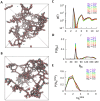Self-Assembly in an Experimentally Realistic Model of Lobed Patchy Colloids
- PMID: 36698242
- PMCID: PMC10880053
- DOI: 10.1021/acsabm.2c00910
Self-Assembly in an Experimentally Realistic Model of Lobed Patchy Colloids
Abstract
Colloids with lobed architectures have been shown to self-assemble into promising porous structures with potential biomedical applications. The synthesis of these colloids via experiments can be tuned to vary the number and the position of the lobes. However, the polydispersity involving the numbers, sizes, and the dispositions of lobes, that is often observed in particle designs, can significantly affect their self-assembled structures. In this work, we go beyond the uniform lobe size conditions commonly considered in molecular simulations, and probe the effect of polydispersity due to non-uniform lobe sizes by studying self-assembly in three experimentally observable designs of lobed particles (dumbbell, two lobes; trigonal planar, three lobes; and tetrahedral, four lobes), using coarse-grained Langevin dynamics simulations in the NVT ensemble. With increasing polydispersity, we observed the formation of a crystalline structure from a disordered state for the dumbbell system, and a loss of order in the crystalline structures for the trigonal planar system. The tetrahedral system retained a crystalline structure with only a minor loss in compactness. We observed that the effect of polydispersity on the self-assembled morphology of a given system can be minimized by increasing the number of lobes. The polydispersity in the lobe size may also be useful in tuning self-assemblies toward desired structures.
Keywords: Langevin dynamics; Self-assembly; lobed colloids; polydispersity; porosity.
Conflict of interest statement
The authors declare no competing financial interest.
Figures



 ).
).
 ).
).
 ), and the lobe-size
and bond distributions
for (F) σG = 0.1 and (G) σG = 0.5.
), and the lobe-size
and bond distributions
for (F) σG = 0.1 and (G) σG = 0.5.
 ).
).Similar articles
-
Porous Self-Assemblies Mediated by Dumbbell Particles as Cross-Linking Agents.J Chem Theory Comput. 2024 Feb 27;20(4):1590-1599. doi: 10.1021/acs.jctc.3c00406. Epub 2023 Aug 31. J Chem Theory Comput. 2024. PMID: 37650723
-
Self-assembly behavior of experimentally realizable lobed patchy particles.Soft Matter. 2020 Sep 16;16(35):8101-8107. doi: 10.1039/d0sm00954g. Soft Matter. 2020. PMID: 32935732
-
Enhanced Porosity in Self-Assembled Morphologies Mediated by Charged Lobes on Patchy Particles.J Phys Chem B. 2021 Apr 1;125(12):3208-3215. doi: 10.1021/acs.jpcb.0c11096. Epub 2021 Mar 18. J Phys Chem B. 2021. PMID: 33734699
-
Molecular Recognition in the Colloidal World.Acc Chem Res. 2017 Nov 21;50(11):2756-2766. doi: 10.1021/acs.accounts.7b00370. Epub 2017 Oct 6. Acc Chem Res. 2017. PMID: 28984441 Review.
-
Organic-inorganic nanostructured colloids.J Nanosci Nanotechnol. 2002 Feb;2(1):1-24. doi: 10.1166/jnn.2002.075. J Nanosci Nanotechnol. 2002. PMID: 12908313 Review.
Cited by
-
Co-Assembly of Cancer Drugs with Cyclo-HH Peptides: Insights from Simulations and Experiments.ACS Appl Bio Mater. 2024 Apr 15;7(4):2309-2324. doi: 10.1021/acsabm.3c01304. Epub 2024 Mar 13. ACS Appl Bio Mater. 2024. PMID: 38478987 Free PMC article.
References
-
- Dinsmore A. D.; Crocker J. C.; Yodh A. G. Self-assembly of colloidal crystals. Curr. Opin. Col. Interface Sci. 1998, 3, 5–11. 10.1016/S1359-0294(98)80035-6. - DOI
-
- Glotzer S. C.; Solomon M. J.; Kotov N. A. Self-assembly: From nanoscale to microscale colloids. AIChE J. 2004, 50, 2978–2985. 10.1002/aic.10413. - DOI
-
- Lu P. J.; Weitz D. A. Colloidal particles: crystals, glasses, and gels. Annu. Rev. Condens. Matter Phys. 2013, 4, 217–233. 10.1146/annurev-conmatphys-030212-184213. - DOI
Publication types
MeSH terms
Substances
LinkOut - more resources
Full Text Sources
